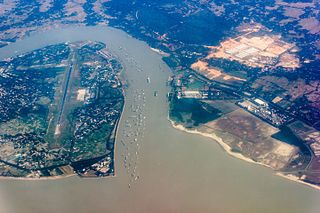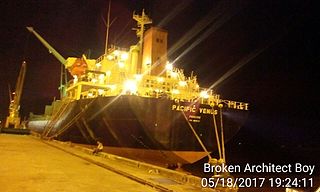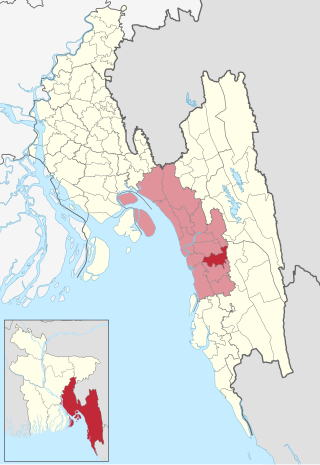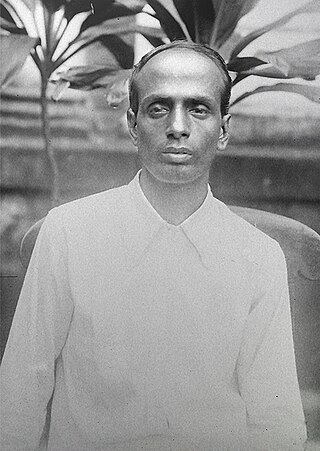Related Research Articles

Chittagong, officially Chattogram, also known as Chatgaon, is the second-largest city in Bangladesh after Dhaka and the third largest city in the Bengal region after Dhaka and Kolkata. It is the administrative seat of the eponymous division and district. It hosts the busiest seaport on the Bay of Bengal. The city is located on the banks of the Karnaphuli River between the Chittagong Hill Tracts and the Bay of Bengal. The Greater Chittagong Area had a population of more than 5.2 million in 2022. In 2020, the city area had a population of more than 3.9 million. Even amidst heightened global uncertainty, Bangladesh has consistently demonstrated a robust history of growth and advancement.

Karnaphuli, or Khawthlangtuipui, is the largest and most important river in Chattogram and the Chattogram Hill Tracts. It is a 667-metre (2,188 ft) wide river in the south-eastern part of Bangladesh. Originating from the Saithah village of Mamit district in Mizoram, India, it flows 270 kilometres (170 mi) southwest through Chattogram Hill Tracts and Chattogram into the Bay of Bengal. Before the Padma, it was the fastest flowing river in Bangladesh. It is said to "represent the drainage system of the whole south-western part of Mizoram." Principal tributaries include the Kawrpui River or Thega River, Tuichawng River and Phairuang River. A large hydroelectric power plant using Karnaphuli river was built in the Kaptai region during the 1960s. The mouth of the river hosts the Port of Chattogram, the largest and busiest seaport of Bangladesh.

The Port of Mongla is a link sea port, located at Mongla Upazila, Khulna Division, Bangladesh. It is a sea port of Khulna city which is located near to the north. It is the second largest and second busiest seaport of Bangladesh. Mongla port lies close to the shore of Bay of Bengal and Pashur river. Mongla is renowned among the major important ports of the Bengal delta. Due to the increasing congestion in Bangladesh's largest port in Chittagong, many international shipping companies have turned to Mongla as an alternative. Also the influence of continuous demanding from all over the country and neighbouring countries made it busier and economically eye catching day by day.

Chittagong District, renamed the Chattogram District, is a district located in the south-eastern region of Bangladesh. It is a part of the Chittagong Division. The port city of Chittagong, which is the second largest city in Bangladesh, is located within this district.

The Chittagong Stock Exchange is a stock exchange based in the port city Chittagong, Bangladesh. It is one of the twin financial hubs of the country, alongside the Dhaka Stock Exchange. Established in 1995, the exchange is located in the Agrabad business district in downtown Chittagong. It has a combined market capitalization of over US$ 38 billion as of 2020.

Chandanaish is an upazila of Chattogram District in Chattogram Division, Bangladesh.

Hathazari is an upazila of Chattogram District in Chattogram Division, Bangladesh.

Sandwip is an upazila of Chattogram District in Chattogram Division, Bangladesh. It encompasses the islands of Sandwip and Urir Char.
Madhabpur is an upazila (sub-district) of Habiganj District, located in Bangladesh's Sylhet Division.

Chittagong Veterinary and Animal Sciences University (CVASU) is a public university in Bangladesh. It is the only specialised veterinary university in Bangladesh. It is located at Khulshi, Chattogram. The chancellor of the university is president Mohammed Shahabuddin. Generally, the public universities in Bangladesh offer degree on department. Like every other agricultural university in Bangladesh, CVASU offers degree on faculty.

The Bengal Sultanate was a late medieval sultanate based in Bengal region between the 14th and 16th century. It was the dominant power of the Ganges-Brahmaputra Delta, with a network of mint towns spread across the region. The Bengal Sultanate had a circle of vassal states in the subcontinent, including parts of Odisha in the southwest, Arakan in the southeast, and Tripura in the east.

Surya Sen, also called Surya Kumar Sen, was an Indian revolutionary who was influential in the independence movement against British rule in India and is best known for leading the 1930 Chittagong armoury raid.

The city of Chattogram (Chittagong) is traditionally centred around its seaport which has existed since the 4th century BCE. One of the world's oldest ports with a functional natural harbor for centuries, Chittagong appeared on ancient Greek and Roman maps, including on Ptolemy's world map. Chittagong port is the oldest and largest natural seaport and the busiest port of Bay of Bengal. It was located on the southern branch of the Silk Road. The city was home to the ancient independent Buddhist kingdoms of Bengal like Samatata and Harikela. It later fell under of the rule of the Gupta Empire, the Gauda Kingdom, the Pala Empire, the Chandra Dynasty, the Sena Dynasty and the Deva Dynasty of eastern Bengal. Arab Muslims traded with the port from as early as the 9th century. Historian Lama Taranath is of the view that the Buddhist king Gopichandra had his capital at Chittagong in the 10th century. According to Tibetan tradition, this century marked the birth of Tantric Buddhism in the region. The region has been explored by numerous historic travellers, most notably Ibn Battuta of Morocco who visited in the 14th century. During this time, the region was conquered and incorporated into the independent Sonargaon Sultanate by Fakhruddin Mubarak Shah in 1340 AD. Sultan Ghiyasuddin Azam Shah constructed a highway from Chittagong to Chandpur and ordered the construction of many lavish mosques and tombs. After the defeat of the Sultan of Bengal Ghiyasuddin Mahmud Shah in the hands of Sher Shah Suri in 1538, the Arakanese Kingdom of Mrauk U managed to regain Chittagong. From this time onward, until its conquest by the Mughal Empire, the region was under the control of the Portuguese and the Magh pirates for 128 years.
The Chittagong Club is one of the most prominent and prestigious social clubs in Bangladesh. Founded as a gentlemen's club during British rule in 1878, it is one of the oldest elite social clubs in South Asia. It is located at S.S. Khaled Road, Chittagong, Bangladesh.

The city known in English as Chittagong has undergone changes in both its official and popular names worldwide. The choice of names stems from the Chittagonian culture, language and colonisation. A reason for the city having a number of names is due to the diverse history of Chittagong.
Pranab Kumar Chowdhury is a Bangladeshi pediatrician, academic and writer. He authored many books on child healthcare as well as children's fictions in Bengali. He also co-authored a text book on paediatrics. He was awarded 'Swadhinata Smarak Sommanona Padak' by Chittagong City Corporation in 2017 for his contribution in child healthcare. He regularly writes articles on children's care in popular newspapers. His six-part book on children's healthcare in Bengali was lauded by Shamsuzzaman Khan and Anisuzzaman. He is the former professor and head of the Department of Paediatrics, Chittagong Medical College, Chittagong, Bangladesh.

Bangladesh Television Chattogram or Bangladesh Television Chittagong, branded on-air as BTV Chittagong or BTV Chattogram, sometimes known as CTV, is a BTV-affiliated television station broadcast from Chittagong, serving southeastern Bangladesh. It is the network's first and currently the only regional television station. It was launched in 1996 and initially broadcast for one and a half hour, but the broadcast schedule significantly increased over time. It broadcasts on a full-day basis daily on both terrestrial and satellite television. BTV Chittagong started broadcasting on satellite television in 2016. It is also a nationwide terrestrial television station along with BTV Dhaka and Sangsad Television, as it reaches 75% of the area of Bangladesh terrestrially.
Syed Muhammad Muqim was an 18th-century Bengali poet, author and philosopher who was active during the advent of company rule in Bengal. His puthis are notable as they are interspersed with his own philosophical thoughts on prosody, music, astrology and religions.
Biponi Bitan is the largest commercial shopping center in Chittagong, Bangladesh. It is located at New Market Junction on Jubilee Road in the city.
Cinema Palace is an old movie theatre in Chittagong, Bangladesh. It was formally known as Theater Hall.
References
- 1 2 Sirajul Islam; Miah, Sajahan; Khanam, Mahfuza; Ahmed, Sabbir, eds. (2012). "Bangladesh". Banglapedia: the National Encyclopedia of Bangladesh (Online ed.). Dhaka, Bangladesh: Banglapedia Trust, Asiatic Society of Bangladesh. ISBN 984-32-0576-6. OCLC 52727562. OL 30677644M . Retrieved 18 November 2023.
- 1 2 3 4 Khaled, Mohammed, ed. (November 1995). "Dewanhat". City Life. Hajar Bachhorer Chattogram (35th Anniversary Special Issue). Chittagong: MA Malek Dainik Azadi. p. 297.
- ↑ Khaled, Mohammed, ed. (November 1995). "A brief history". History. Hajar Bachhorer Chattogram (35th Anniversary Special Issue). Chittagong: MA Malek Dainik Azadi. p. 27.